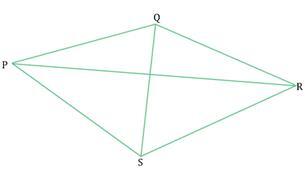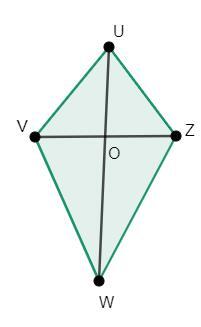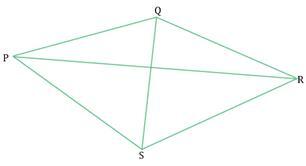
 Data Structure
Data Structure Networking
Networking RDBMS
RDBMS Operating System
Operating System Java
Java MS Excel
MS Excel iOS
iOS HTML
HTML CSS
CSS Android
Android Python
Python C Programming
C Programming C++
C++ C#
C# MongoDB
MongoDB MySQL
MySQL Javascript
Javascript PHP
PHP
- Selected Reading
- UPSC IAS Exams Notes
- Developer's Best Practices
- Questions and Answers
- Effective Resume Writing
- HR Interview Questions
- Computer Glossary
- Who is Who
Area of Quadrilateral
Introduction
Area of a quadrilateral is the region enclosed by the sides of the quadrilateral. The quantity of territory contained within a quadrilateral determines its area. Let's review the definition of a quadrilateral. A closed shape with four line segments enclosing it is referred to as a quadrilateral. Both regular and irregular quadrilaterals exist. A quadrilateral with regular sides is one with equal-length sides. An irregular quadrilateral is a quadrilateral that is not regular.
There are six different kinds of quadrilaterals. Square, rectangle, parallelogram, trapezoid, rhombus, kite, etc. In this tutorial, we discuss areas of all these quadrilaterals. We'll look at how to divide a quadrilateral into two triangles and how to calculate its area by counting its four sides. We will also learn the formulas for calculating the areas of each of these various quadrilateral shapes.
Quadrilaterals
A quadrilateral is a closed object in geometry that is created by connecting four points, any three of which are not collinear. There are 4 sides, 4 angles, and 4 vertices in a quadrilateral. A quadrilateral may or may not have equal sides on all four sides. The arrangement of the vertices must be taken into consideration whenever a quadrilateral is named.
The following quadrilateral, for instance, should be referred to as PQRS, QRSP, PSRQ, or RSPQ. Since they alter the order of vertices in which a quadrilateral is generated, it cannot be termed PRSQ or SQPR. A quadrilateral with the letters PQRS has four sides: PQ, QR, RS, and PS, as well as two diagonals: PR and QS.

Area of Different Quadrilaterals
The quantity of territory contained within a quadrilateral determines its area. The quadrilaterals are Square, rectangle, parallelogram, trapezium, rhombus, kite, etc.
In addition to learning how to divide a quadrilateral into two triangles, you'll also learn how to count the sides of a quadrilateral to determine its area. Additionally, we'll study the formulas for computing the surface areas of each of these different
Squares & Rectangles
Square is a quadrilateral with all four edges the same in length and all four angles are of the same measure that is 90 degrees. If the length of each side of the square is a then the formula to find the area of the square is side2
$$\mathrm{area =a^2, where\: a\: is\: the\: length\: of\: the\: side}$$
Example
Area of square with side length 3 cm is 32=9 sq. cm
In a rectangle quadrilateral pair of opposite edges are equal and parallel and each angle is of measure 90 degrees. If the length and breadth of the rectangle is l & b then the formula to calculate area of rectangle is lengthÃbreadth=lb
Example
Area of rectangle with 2 cm length and 1 cm width is lb=2(1)=2 sq. cm
Rhombuses & Parallelograms
In rhombus all the edges are equal in length and pairs of opposite edges are parallel. Opposite angles are equal and diagonals are perpendicular bisectors of each other. If d1 & d2 are lengths of two diagonals then the area of the rhombus is given by the formula $\mathrm{\frac{1}{2}Ãd_1Ãd_2}$
Example
Area of the rhombus with diagonals 5cm and 8cm is $\mathrm{\frac{1}{2}Ãd_1Ãd_2=\frac{1}{2}Ã5Ã8=20}$ sq. cm
In Parallelogram the pair of opposite edges are equal and parallel. Pair of opposite angles are equal and diagonals bisect each other. If b is the base and h is the height of the parallelogram then its area is calculated by seÃheight=bh .
Example
Area of parallelogram with base 10 cm and height 4 cm is bh=10(4)=40 sq. cm
Trapeziums
In trapezium only one pair of opposite edges is parallel. If a & b are lengths of two opposite parallel sides and h is the distance between them i.e. height of the quadrilateral then the area of trapezium is given by the formula $\mathrm{\frac{1}{2}Ã(a+b)Ãh}$
Example
If 5cm and 7cm are lengths of two parallel sides in the trapezium and 4 cm is the distance between them then its area is $\mathrm{\frac{1}{2}Ã(a+b)Ãh=\frac{1}{2}Ã(5+7)Ã4=12Ã2=24 }$ sq. cm
Kites
Following is the geometric figure kite UVWZ in which UV=UZ,VW=ZW
that is adjacent edges are equal in length and diagonals bisect each other at the point O.

Area of the kites can be found by adding the areas of two triangular regions namely UVZ and VWZ. The area of the kite can also be found out using lengths of the diagonals.
If d1 & d2 are lengths of two diagonals then the area of the kite is given by the formula $\mathrm{\frac{1}{2}Ãd_1Ãd_2}$
Generic Quadrilaterals
Following quadrilateral is a generic quadrilateral. Its area can be found by adding the areas of the two triangles it is being divided due to any one of the diagonals.

Example
$$\mathrm{ar(PQRS)=ar(PQS)+ar(QRS) or =ar(PQR)+ar(PSR)}$$
Solved Examples
1)Calculate the area of a kite whose diagonals are 16 and 14.
Answer : Given that d1=16 & d2=14
Thus the area of the given kite is determined as
$$\mathrm{\frac{1}{2}Ãd_1Ãd_2=\frac{1}{2}Ã16Ã14=112 \:sq. units}$$
2)Find the area of a trapezoid with bases of 12 inches and 8 inches and a height of 4 inches using the formulas for quadrilateral area.
Answer: Given that a=12 inches,b=8 inches & h=4 inches
Using the formula,
Area of trapezium is given by
$$\mathrm{\frac{1}{2}Ã(a+b)Ãh=\frac{1}{2}Ã(12+8)Ã4=20Ã2=40\: sq. inches}$$
3)Determine the area of following quadrilateral using the Heron's formula

Answer: To find the area of the triangle ABC using Heron's formula
$$\mathrm{s=\frac{3+5+7}{2}=7.5}$$
So,
$$\mathrm{area=\sqrt{s(s-a)(s-b)(s-c)}=\sqrt{7.5(7.5-3)(7.5-5)(7.5-7)}=\sqrt{42.1875}}$$
To find the area of the triangle ADC using Heron's formula
$$\mathrm{s=\frac{6+7+8}{2}=10.5}$$
So,
$$\mathrm{area=\sqrt{10.5(10.5-6)(10.5-7)(10.5-8)}=\sqrt{413.4375}}$$
Thus, the area of the required quadrilateral is given by
$$\mathrm{area=\sqrt{42.1875}+\sqrt{413.4375}\: sq. units}$$
Conclusion
Surface area of the quadrilateral is the area of the region between the boundaries of the quadrilateral.
There are different types of quadrilaterals and their respective formulas to find the areas as discussed above.
FAQs
1. How do you calculate a quadrilateral's area?
The area of the quadrilateral is computed as follows if the diagonal and the length of the perpendiculars from the vertices are known
Area of quadrilateral = (1/2) diagonal length x sum of the length of the perpendiculars drawn from the remaining two vertices.
2. Which quadrilateral face has equal sides?
A closed shape with four line segments enclosing it is referred to as a quadrilateral. Both regular and irregular quadrilaterals exist. A quadrilateral with regular sides is one with equal-length sides.
3. What is the name of a four-sided irregular shape?
A quadrilateral is a shape that has four sides and four angles. Any quadrilateral whose sides are of the same length is said to be regular. An irregular quadrilateral is one whose sides are not all the same length since it is not a regular quadrilateral.
4. What are 3 facts about quadrilaterals?
A polygon with four sides and four corners is called a quadrilateral. A quadrilateral is derived from the words quad, which means four, and lateral, which means of sides. Quadrilaterals have inner angles that add up to 360 degrees.
5. What connections do quadrilaterals have to one another?
There are many different kinds of quadrilaterals, but they all have four sides, two diagonals, and internal angles that add up to 360 degrees. They are all connected to one another, but they are all unique and have various characteristics.

